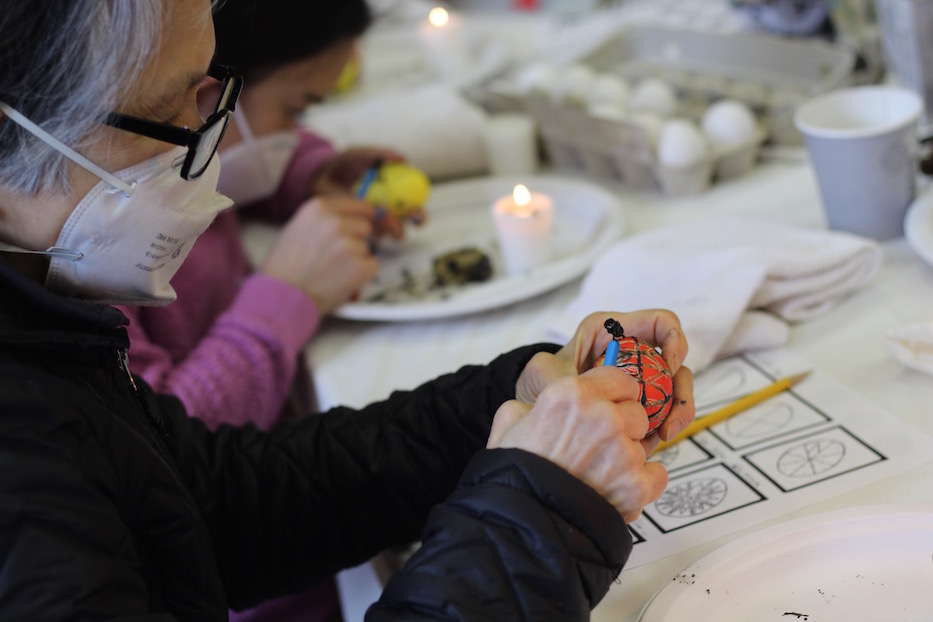
Dwight | Arts & Culture | News From The Pews | Ukraine
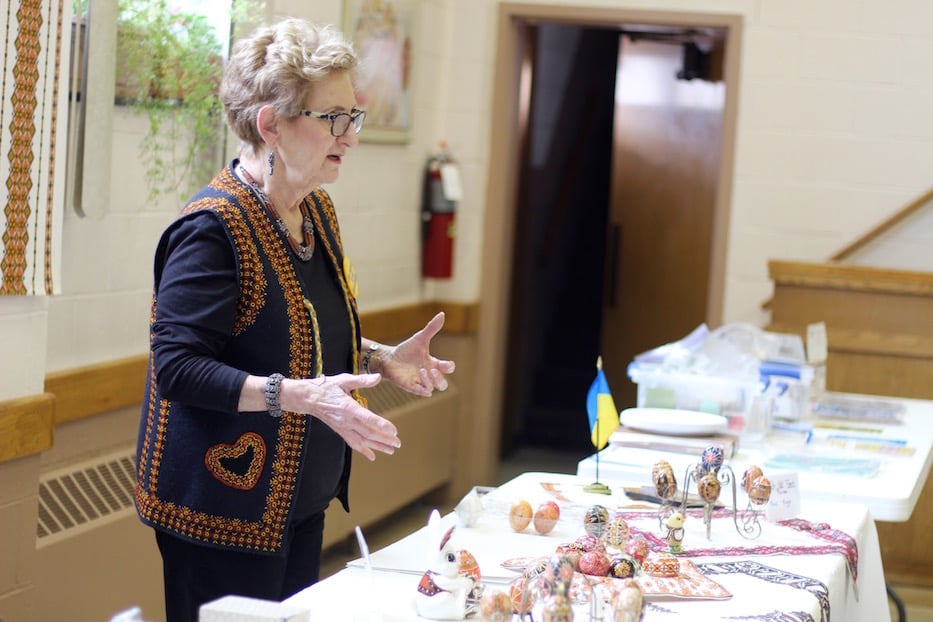
Gloria Horbaty, who has been teaching pysanky workshops for decades. Lucy Gellman Photos.
Gloria Horbaty lowered an egg into a bath of purple dye, deciphering the thick drips of wax on its surface. A criss-cross of pine needles suggested a long life. A reindeer stood in for health and prosperity. A windmilling, wide golden sun signalled the coming of spring. As she dipped a spoon into the liquid to retrieve it, she reached back into generations of family history, pulling out a story of tradition that she is working to keep alive.
For the first time in two years, Horbaty returned to St. Michael the Archangel Ukrainian Catholic Church to teach a workshop on pysanky—the ornate, polychrome Ukrainian Easter eggs made using the wax-resist method. It is the first time since the beginning of the Covid-19 pandemic that she has been able to teach the art form, which she grew up learning from her mother. Close to two dozen came out to the church’s parish hall, located just off of George Street in the city’s Dwight neighborhood.
Horbaty, who leads the Connecticut Ukrainian-American Historical Society and Ethnic Heritage Center at Southern Connecticut State University, will lead a second workshop at the Wilson Branch of the New Haven Free Public Library on April 7 from 4 to 6 p.m.. More information is available here.
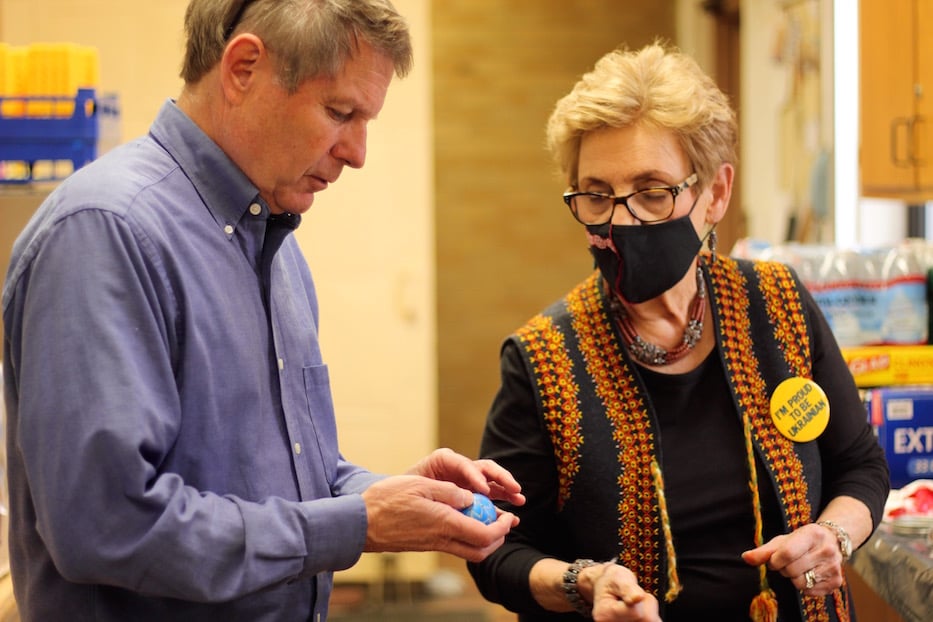
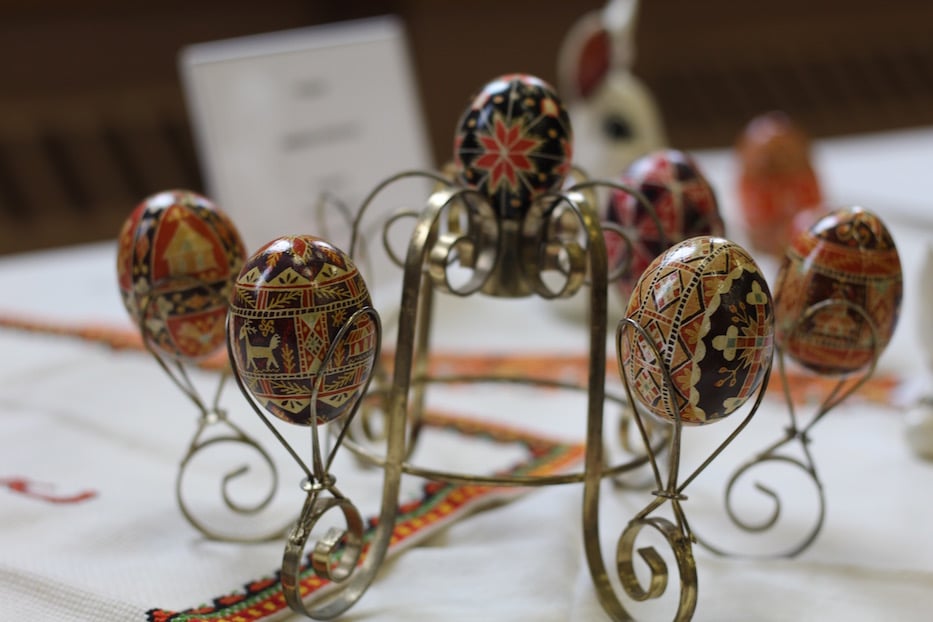
Top: Bruce Marshall and Gloria Horbaty. Bottom: Ukrainian pysanky.
“Some people read palms—I read eggs,” she said as she assembled paper plates with blocks of wax, sharpened pencils, candles and wooden and copper-wrapped kistky. “I just want people to appreciate the beautiful culture of Ukraine. I’m carrying on a tradition that … God knows when we will be able to do it again in Ukraine.”
Pysanky (singular pysanka) were born centuries ago, as part of a rich cultural tradition that married folk art with the agrarian calendar. During the winter months when the earth froze and sheep herding slowed, people—“our ancestors,” as Horbaty put it Sunday—were inside their homes more. They began to decorate the eggs, the most traditional of which still use a method that includes a candle, block of wax, natural dyes and a Pussy Willow branch wrapped in copper called a kistka.
The intricacy and care of the process ties modern-day Ukrainians to their roots, Horbaty said. In August 2013, archaeologists in Lviv uncovered a pysanka that they estimated dated back hundreds of years. Prior to the pandemic, Lviv hosted an annual festival celebrating the eggs, in which artists painted, crocheted, and collaged their own larger-than-life versions in the center of the city. In the Western Ukrainian town of Kolomyya, there's an entire museum dedicated to the art form. This week, that history seems especially distant as Russian missiles target and strike Western Ukraine.
And yet, pysanky are also a symbol of resilience. Presented on the cusp of Easter, they represent the coming of spring and the resurrection of Jesus Christ. Many Ukrainians include them in their Easter baskets, for which there is a traditional blessing at Ukrainian churches on Holy Saturday. Horbaty has met first-and second-generation Ukrainian immigrants who are excited to learn or relearn the art form, which Soviet forces banned after World War II. From the 1940s to the 1990s, the practice of pysanky writing was deemed a religious symbol, and outlawed in parts of the country.
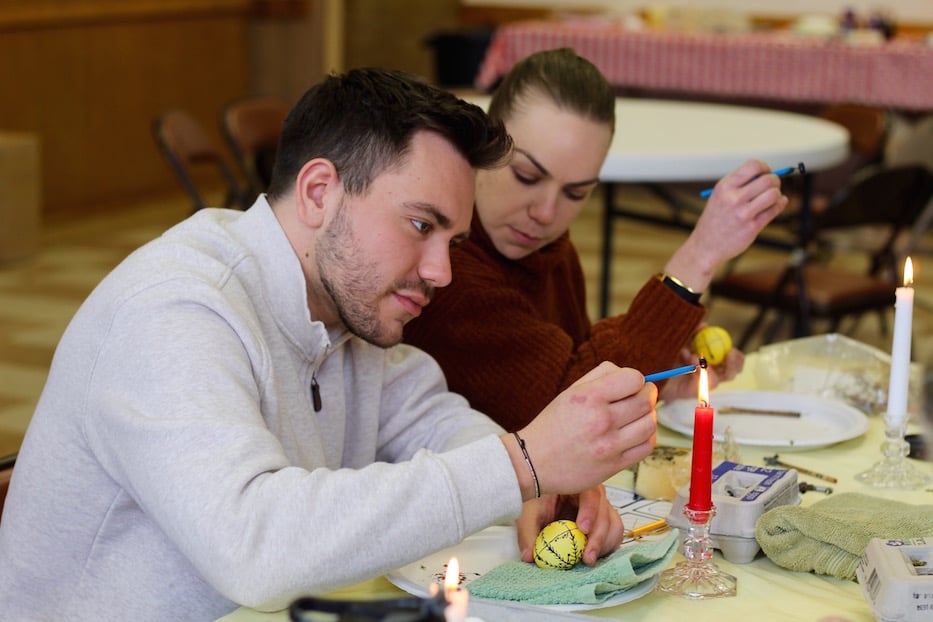
Siblings John and Stephanie Dytko. John is studying mechanical engineering at Northeastern in Boston and Stephanie is a middle school math teacher.
Horbaty learned the art form from her mother, a Ukrainian-American woman named Olga Liteplo Paproski. Born in Youngstown, Ohio and raised between Ohio and Lviv, Paproski grew up as the third of seven surviving children to Ukrainians trying to build a better life for themselves and their family. When the Second World War began, her parents sent her to New York, where her older brother was already living. It was at a wedding there that she met her future husband, a Connecticut dairy farmer named Sam Paproski.
Their marriage brought her to Castle Hill Farm, still located in Newtown. Decades later, Horbaty still helps run an annual Ukrainian festival there. Last summer marked its 45th year.
As a child, Horbaty watched her mother teach pysanky workshops to women’s leagues and Ukrainian societies across the state. During those presentations, she brought more than just supplies to make the eggs—she also came ready to tell her story. During World War II, much of her family was sent to Siberia. She had been able to escape the war because she, like two of her siblings, was born on American soil. Knowing so many had not been able to escape the war, “she wanted to teach Americans about communism,” Horbaty said.
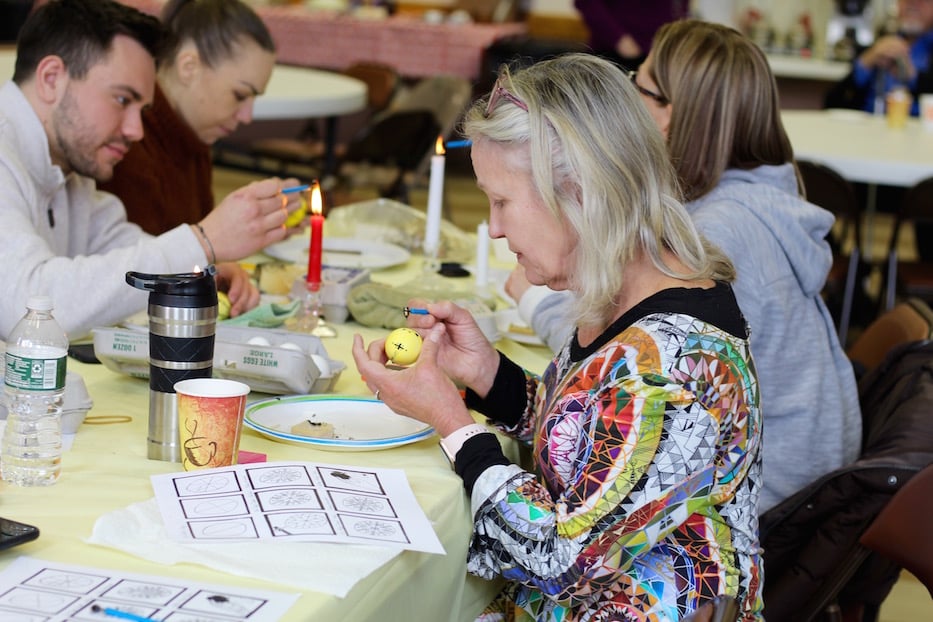
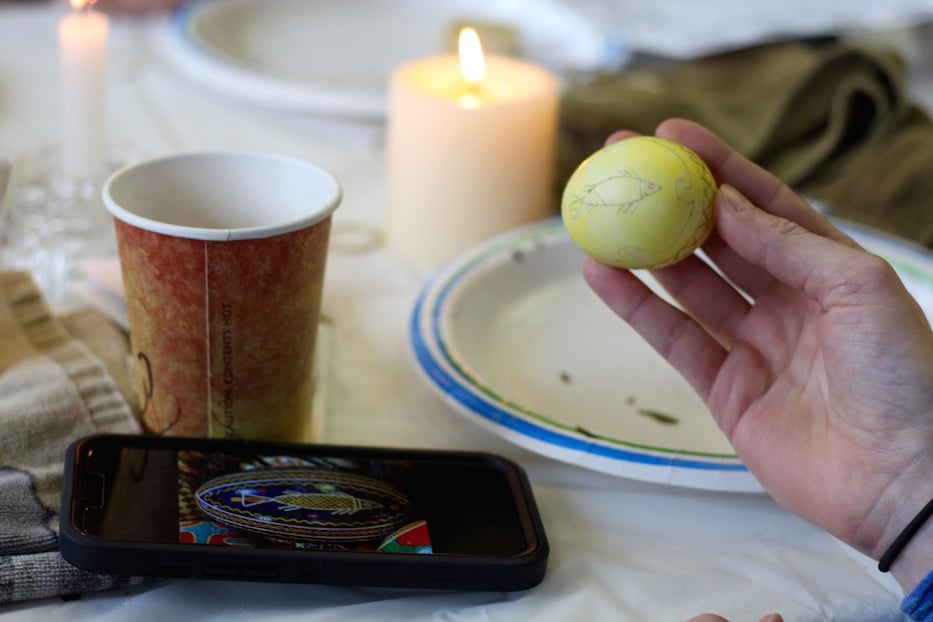
Top: Christine Spock. Bottom: Melanie Hauser's design. She came to the event Sunday with her mom, Christine (neither of them wanted to be photographed).
Horbaty still has her first pysanka, completed when she was just six years old. Now, she sees it as her responsibility to carry on the tradition. Sunday, old-school dyes, embossed blocks of wax, flickering candles and pristine blue- and red-handled kistky sat close to egg blowers, pysanky egg wraps on heat-shrink sleeves, and sheets on how to recreate the pysanka process from start to finish at home. She joked that attendees might not want to leave them in a hot cabinet—and risk an olfactory assault if they do.
Throughout the room, each egg—and each maker—had a story that dipped into decades of history, as complex and richly layered as the pysanky themselves. Close to a stage strung with paper stars, Hope Langer-Marshall began to sketch out climbing branches around an eight-pointed star, and let the design transport her back to a childhood spent in Ukrainian school at St. Michael’s.
As a kid, Langer-Marshall grew up learning how to do pysanky from her grandmother, a Ukrainian-American who married an immigrant from Putiatynce, a village in Western Ukraine. For her, the eggs were part of a proud Ukrainian upbringing that also included Ukrainian dance, cultural school, and weekly services at St. Michael's. The church has been her spiritual home for over six decades—she started attending as a baby, and hasn’t left since. Her cousin, Halia Lodynsky, is still a fellow parishioner and teacher there.
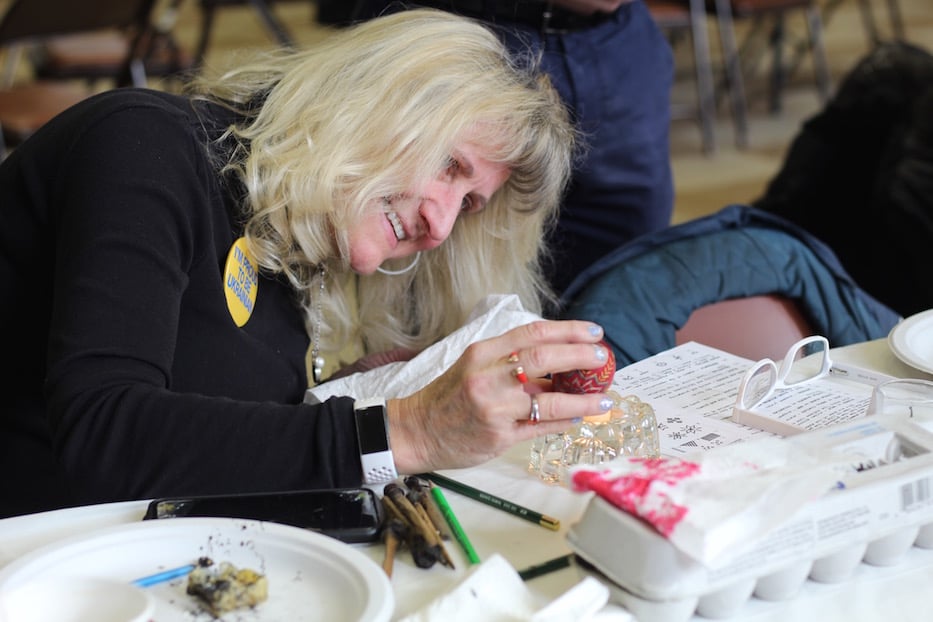
Hope Langer-Marshall: “You hate to think that this is how people get to know Ukraine, through a tragedy like this, but they also come to celebrate our traditions and our joy.”
Langer-Marshall learned the process by warming the wax-coated egg in the oven, rather than over the open flame of a candle. The rest of the technique—sketching out a pattern on the eggs, alternating multiple coats of dye with wax to protect the layers underneath, and then burning the wax off—was the same. She has since tried to pass the tradition on to her two adult children, who are 24 and 27.
“We would always do it generationally,” she recalled as she planned out an initial coat of yellow dye, and later layers of blue, black and red. “The eggs are just tradition to carry on.”
This year, she’s balancing the joy of the forthcoming Easter holiday with the reality of a country upended by war. Four years ago, Langer-Marshall and her husband Bruce were able to visit the village where her grandfather grew up. Now, she doesn’t know what’s left of it. As she made clear, careful marks across the egg, she said that she’s focusing on the fact that Ukraine is more visible now than it has been for decades—and people suddenly want to understand more of its rich culture.
“You know what? I’m so happy to see so many people here from the community,” she said. “You hate to think that this is how people get to know Ukraine, through a tragedy like this, but they also come to celebrate our traditions and our joy.”
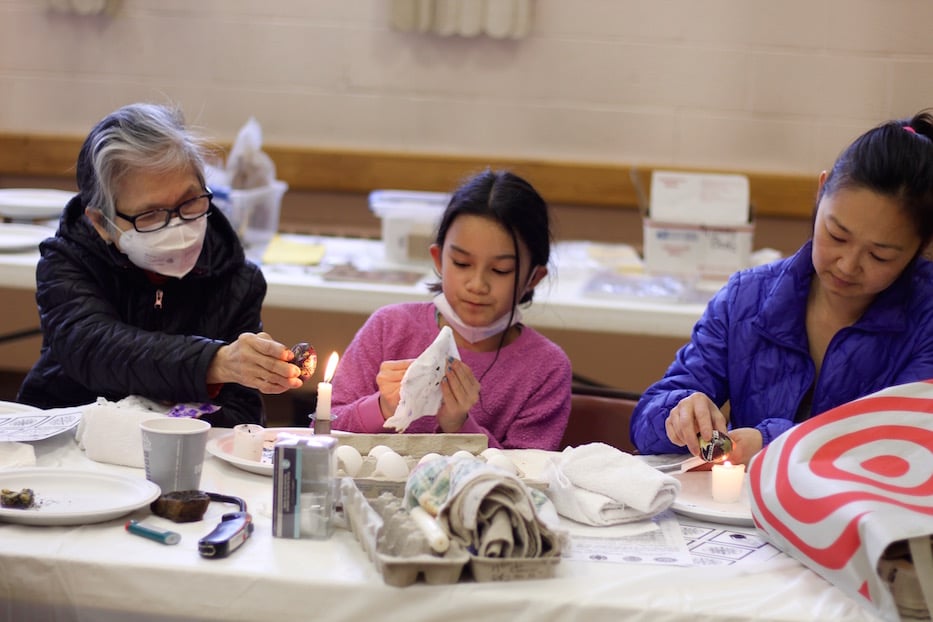
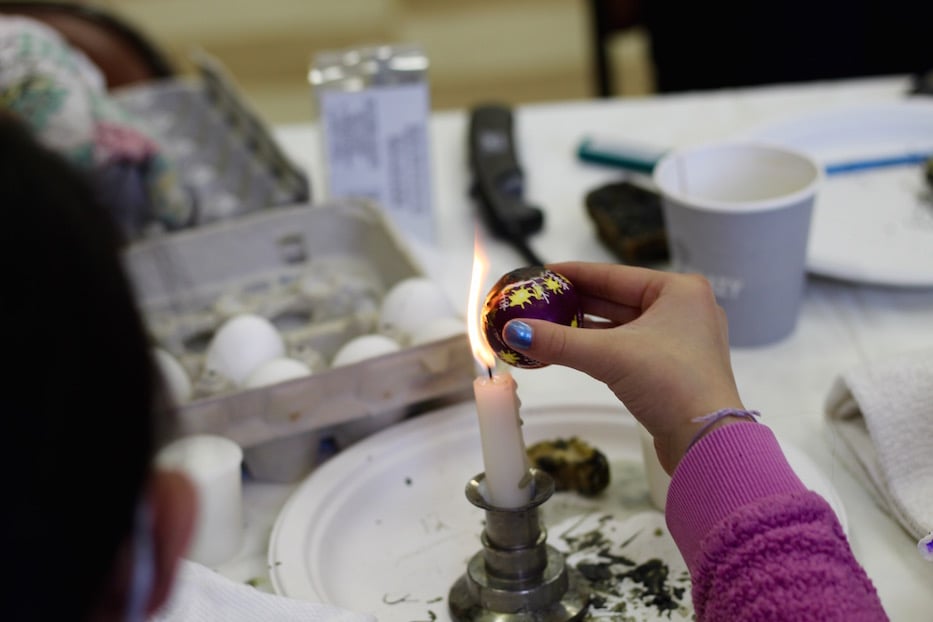
Rosita Chi, Annika Civitello and her mom, Claudine Civitello.
Across the table, three generations of once-upon-a-time Westvillians worked carefully on their eggs, sketching out sharp-edged, minimal suns, stars with their arms outstretched, and webs of graphite that would, before the end of the afternoon, pulse with vibrant color. Flanked by her daughter Annika and mom Rosita Chi, Claudine Civitello remembered her “adopted Ukrainian Russian grandmother,” whom she referred to endearingly as “Baba” (short for “Babushka”) when she was growing up in Westville. The house, where Chi still lives, wasn’t far from St. Mary's Ukrainian Orthodox Church on Fowler Street.
As she decorated an egg, Chi explained that “Baba” was an older Ukrainian woman who asked to stay in the house after Chi and her husband bought it from her. The two knew that she was elderly and alone, and allowed her to live out the remainder of her life in the house. It meant that Civitello, who now lives in Fairfield, grew up with a kind of unexpected extra grandparent, who fed her cabbage rolls and farmer’s cheese. “She was such a gift,” Civitello said.
“As a kid, I remember seeing this and thinking ‘Oh my God, that’s so cool,” she said of the pysanky. “And then there’s the consciousness of the situation happening in Ukraine right now.”
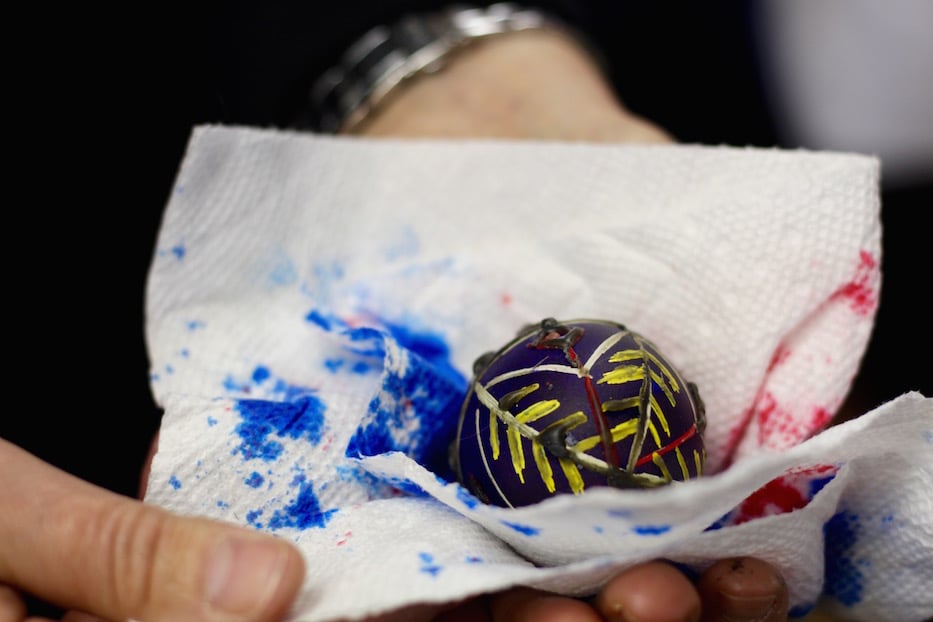
In the church’s small kitchen, Horbaty watched over a cluster of jars filled with dye, fielding requests for yellow, blue, red and purple one by one. Working methodically, she lowered eggs into the baths of color, careful not to let any two touch. She made smalltalk—"she’s brave!” she said when Annika presented a generously-waxed design that glowed purple by the end of the day—and stirred the mixtures of color in between egg dips. When a participant suggested a dye pairing that she didn’t like—a simple blue and yellow, for the Ukrainian flag—she shook her head and sent them back to add more wax.
By the doorway, Linda Springette waited for her egg to emerge from a jar of canary-yellow liquid. A resident of Hamden, Springette started attending St. Michael’s earlier this year, as tensions escalated between Russia and Ukraine. From mass, which she attends each week in English, she added rallies to her cultural wheelhouse. “I wanted to be able to do something, so I started with reconnecting with my roots,” she said.
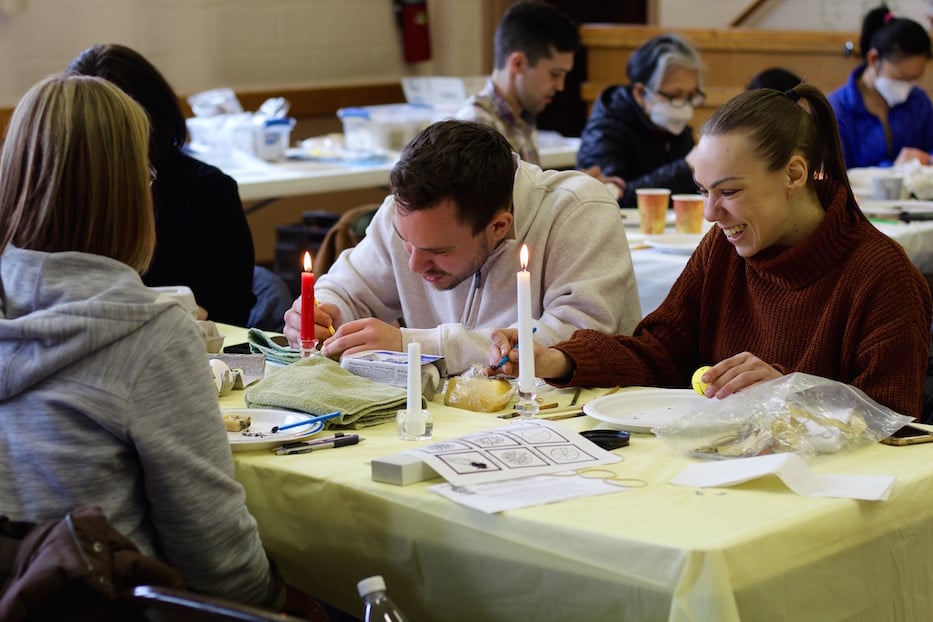
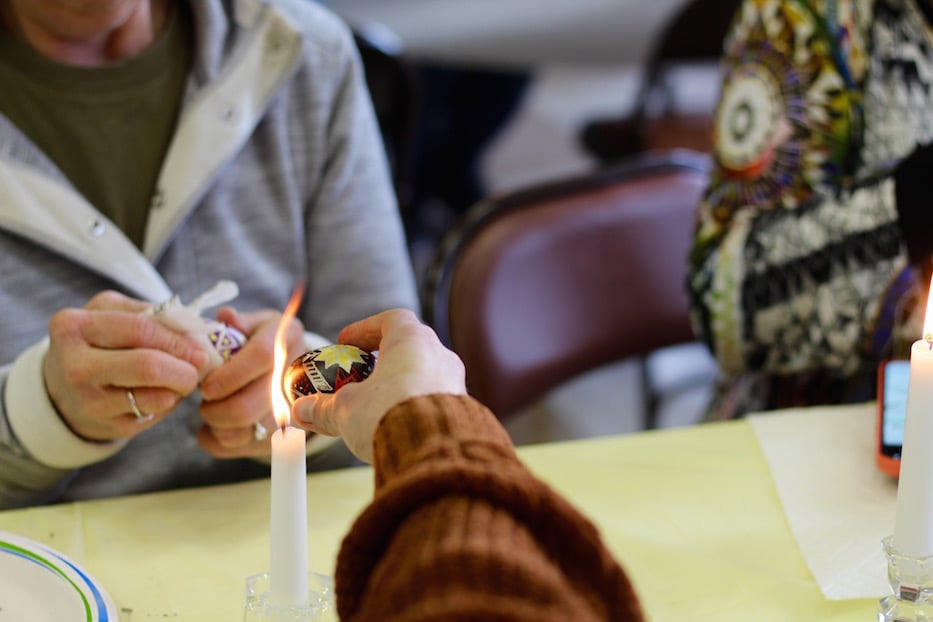
Back at their table, Derby-based siblings Stephanie and John Dytko added new pysanky to a long-running family tradition. As the children of immigrants—their parents were both Ukranians living in Poland, who met at a church pilgrimage after coming to the U.S. in their twenties—they learned the process from their grandmother, Teodora Garan. They still make the eggs each Easter (their mother jokes that she does not have enough patience, John said) using the drop-pull method. This year, their pysanky will double as an homage to Garan, who passed away at 90 earlier this month.
As they chatted, Stephanie proudly pulled out a photo of four immaculate pysanky from Easter 2021, all nestled snugly in an Easter basket. The clean black-and-red outline of a church glinted from one of them. Putting her phone back down, she added careful drips of wax to the inside of an eight-pointed star, where bands of bright color would soon appear. Like Langer-Marshall, she said she’s grateful to see heightened awareness of Ukraine, even if it comes out of tragedy.
“It’s a weird but good feeling to drive around and see these flags,” she said. When she and John were growing up, no one could point to the country on a map, much less name the colors of its flag. Now, she sees blue-and-yellow flags and lawn signs in front of houses and in the windows of small businesses.
“It’s a cool part of your identity to have something that you’re proud of,” John said, jumping in where she’d left off.
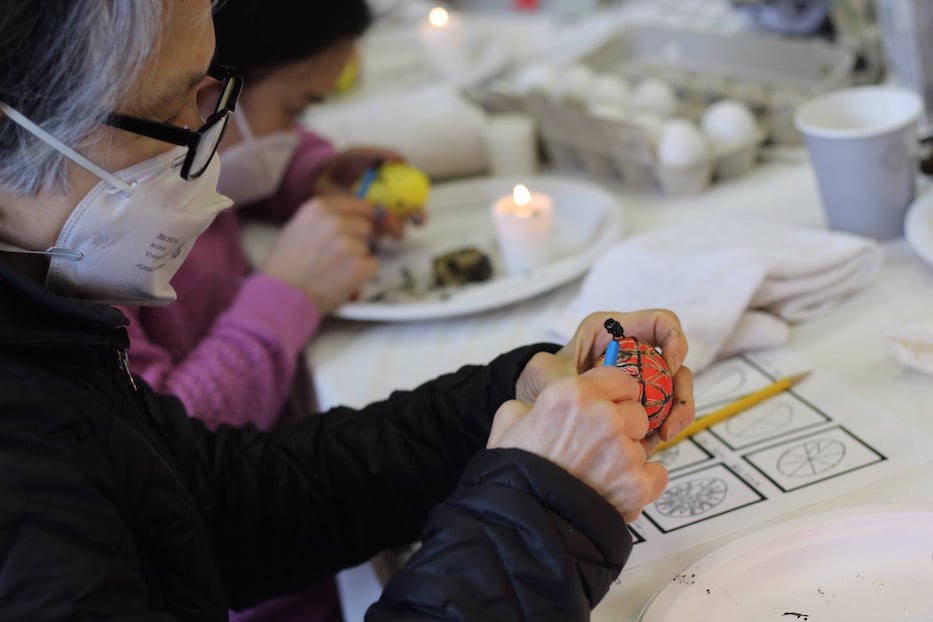
Rosita Chi, who lives in Westville.
By the end of the workshop, tablemates had become new friends, exchanging cell phone numbers and planning for their pierogi and babka orders at the church. When Claudine Civitello fussed over a burn mark from the candle, Horbaty came over to the table, examining the egg before rubbing it gently with a paper towel. One table over, the Dytko siblings looked over two pristine black, red, white and yellow eggs that shone like gemstones in the right light.
The pysanky are only a small part of the church’s efforts to sustain and support Ukrainian culture—and people—as Russian bombardements continue. For weeks, St. Michael’s has been collecting donations of food, diapers, clothing, and medical supplies that it air ships directly to Ukraine from New Haven. Myron Melnyk, a member of both St. Michael’s and the Ukrainian Congress Committee of America, said that medical supplies are the current priority. He motioned to the surrounding parish hall, where stacks and stacks of boxes wait for shipping.
They include painkillers, bandages, tourniquets, coagulants and other “emergency equipment” that hospitals desperately need, Melnyk said. Through REMEDY, a program of Yale New Haven Hospital, the church has been able to work directly with military hospitals in Kyiv and Lviv, where doctors are putting the equipment to immediate use.
It’s expensive work, Melnyk added: each shipment costs about $10,000 to send, and the church is actively asking community members to give if they can afford to do so. So far, the church has sent four shipments by air, and is planning to get another several out this week. To donate, people can give directly to the church.

